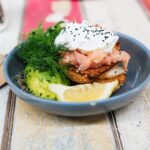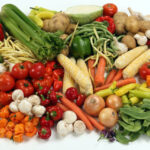Busting Food Myths with Nicole Senior
Myth: Sea salt is healthier
![[NICOLE]](https://glycemicindex.com/blog/2007/dec2007/nicole125.jpg)
Nicole Senior
Fact: All salt contains sodium harmful to your health
Not to be too dramatic, but the saying “pure, white and deadly” is quite fitting for this ubiquitous food ingredient. If it’s good luck you want, you’re better off throwing a pinch of salt over your shoulder than into your dinner. Professor of Medicine at Sydney University Bruce Neal, chair of the Australian division of World Action on Salt and Health (www.awash.org.au) says, “reductions in dietary salt consumption have greater potential to avert death and disability than stopping smoking”. His comment, surprising to many, arises from an investigation published in The Lancet medical journal exploring the costs and benefits of salt reduction and smoking cessation for chronic disease prevention. In short, the study showed we can save lives if we desalinate our food. The problem is, too much salt increases blood pressure and high blood pressure increases the risk of heart attack and stroke: our biggest killers.
![[SALT]](https://glycemicindex.com/blog/2008/dec2008/salt185.jpg)
Sea salt is not healthier Sea salt oozes natural food cred, while exotic and expensive gourmet sea salt is revered in the foodie world. Kosher salt and many other weird and wonderful kinds jostle for our attention. A quick online search revealed extraordinary claims for sea salt that take unhealthy marketing hype to new levels such as: ‘one of God’s gifts,’ ‘salt-deficiency is the cause of many diseases,’ ‘evidence for healing,’ and ‘contains 80 mineral elements the body needs’. The fact is, while sea salt (or any other kind) may add subtle differences in flavour and texture, it contains just as much harmful sodium as regular table salt. In terms of mineral content, the amounts are so small you would need to poison yourself with sodium in order to obtain useful quantities of minerals otherwise found in nutritious foods. For instance, one posh French sea salt with the highest amount of magnesium I could find only contained 0.71g/100 g. If you were to add a very generous 1 teaspoon (5 g) of this stuff to your food on a single day, you would obtain a paltry 0.0355 g (35 mg) of magnesium. This is around 8–11% of the Recommended Dietary Intake of magnesium for adults, but comes with a hefty 2400 mg of sodium: one and a half times the 1600 mg a day Suggested Dietary Target (SDT, Australia and New Zealand). Cheaper sea salts would offer an even worse sodium bang for your magnesium buck.
The bottom line is to add as little salt as possible and recent advice suggests using salt with added iodine (‘iodised’ salt) in order to increase your intake of this essential but hard-to-get trace element. Importantly, check the label of processed food to find the lowest in sodium as this is where the majority of the salt in our diet comes from. If you’d rather starve than cut back on salt, you’re underestimating the marvelous ability of human taste buds to adapt to less salt over time. If you reduce the salt in your diet gradually, the suffering will be minimal. Get into taste sensations offered by garlic, onion, lemon, herbs and spices and soon a whole world of real food flavour will open up.
For more interesting food facts and great tasting heart-friendly recipes with less salt, go to eattobeatcholesterol.com.au . If you’d like great ideas for simple, heart-friendly food made with the goodness of healthy fats and oils with less salt , try Heart Food or Eat to Beat Cholesterol. Both titles available from www.greatideas.net.au.



![[SUN]](https://glycemicindex.com/blog/2008/oct08/nicole_books300.jpg)




